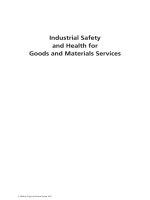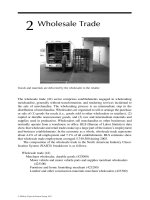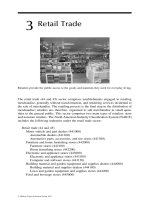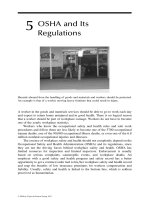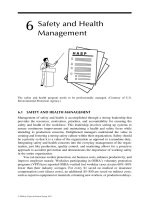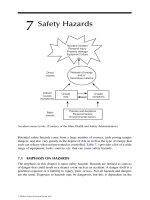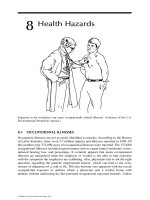Industrial Safety and Health for Goods and Materials Services - Chapter 6 docx
Bạn đang xem bản rút gọn của tài liệu. Xem và tải ngay bản đầy đủ của tài liệu tại đây (139.7 KB, 16 trang )
6
Safety and Health
Management
6.1 SAFETY AND HEALTH MANAGEMENT
Management of safety and health is accomplished through a strong leadership that
provides the resources, motivation, priorities, and accountability for ensuring the
safety and health of the workforce. This leadership involves setting up systems to
ensure continuous improvement and maintaining a health and safety focus while
attending to production concerns. Enlightened managers understand the value in
creating and fostering a strong safety culture within their organization. Safety should
be a priority so that it is a value of the organization as opposed to a mundane duty.
Integrating safety and health concerns into the everyday management of the organ-
ization, just like production, quality control, and marketing allows for a proactive
approach to accident prevention and demonstrates the importance of working safety
in the entire organization.
You can increase worker protection, cut business costs, enhance productivity, and
improve employee morale. Worksites participating in OSHA’s voluntary protection
programs (VPP) have reported OSHA-verified lost workday cases at rates 60%–80%
lower than their industry averages. For every $1 saved on medical or insurance
compensation costs (direct costs), an additional $5–$50 are saved on indirect costs,
such as repair to equipment or materials, retraining new workers, or production delays.
The safety and health program needs to be professionally managed. (Courtesy of U.S.
Environmental Protection Agency.)
ß 2008 by Taylor & Francis Group, LLC.
During 3 years in the VPP, a Ford plant noted a 13% increase in productivity, and a
16% decrease in scrapped product that had to be reworked. Bottom line, safet y does
pay off. Losses prevented go straight to the bottom line profit of an organization. With
today’s competitive markets and narrow profit margins, loss control should be every
manager’s concern. Management actions include the following:
.
Establishing a safety and health policy
.
Establishing goals and objectives
.
Providing visible top management leadership and involvement
.
Ensuring employee involvement
.
Ensuring assignment of responsibility
.
Providing adequate authority and responsibility
.
Ensuring accountability for management, supervisors, and rank and file
employees
.
Providing a program evaluation
6.1.1 SAFETY AND HEALTH POLICY
By developing a c lear statement of management policy, you help everyone involved
with the worksite understand the importance of safety and health protection in
relation to other organizational values (e.g., production vs. safety and health). A
safety and health policy provides an overall direction or vision while setting a
framework from which specific goals and objectives can be developed.
6.1.2 GOALS AND OBJECTIVES
Companies should make general safety and health policy specific by establishing
clear goals and objectives, and make objectives realistic and attainable by aiming at
specific areas of performance that can be measured or verified. Some examples are as
follows: have weekly inspections and correct hazards found within 24 h, or train all
employees about hazards of their jobs, and specific safe behaviors (use of job safety
analysis sheets) before beginning work.
6.1.3 VISIBLE TOP MANAGEMENT LEADERSHIP
Values and goals of top management in an organization tend to get emulated and
accomplished. If employees see the emphasis that the top management puts on safety
and health, they are more likely to emphasize it in their own activities. Besides
following set safety rules themselves, managers can also participate in plant-wide
safety and health inspections, person ally stopping activities or conditions that are
hazardous until the hazards can be corrected, assigning specific responsibilities, par-
ticipating in or helping to provide training, and tracking safety and health performance.
6.1.4 ASSIGNMENT OF RESPONSIBILITY
Everyone in the workplace should have some responsibility for safety and health.
Clear assignment helps avoid overlaps or gaps in accomplishing activities.
ß 2008 by Taylor & Francis Group, LLC.
Safety and healt h is not the sole respon sibility of the safety and healt h profes sional.
Rather, it is everyon e’ s respon sibili ty, while the safet y and health profession al is
a resour ce.
6.1.5 P ROVISION OF AUTHORITY
Any realisti c assi gnmen t of respon sibility must be accom panied by the needed
authority and by having adequat e resources. This incl udes appropr iately trained
and equipp ed person nel as well as suf ficient operat ional and capita l fundi ng.
6.1.6 A CCOUNTABILITY
Accountabi lity is cruci al to helping manag ers, superv isors, and empl oyees under-
stand that they are respon sibl e for their own perfor mance . Rewar d progre ss and
punish when appropr iate. Supervi sors are motivated to do their best when manag e-
ment meas ures thei r performanc e, ‘‘ what gets measured is what gets done. ’’
Take care to ensure that measures accurat ely depict acco mplishment s and d o not
encoura ge negative be haviors such as not report ing accide nts or near misses.
Accountabi lity can be estab lished in safet y throu gh a variety of met hods:
.
Charge backs — Charge accide nt costs bac k to the depart ment or job, or
prorate insurance prem iums.
.
Safety goals — Set safet y goals for manag ement and superv ision (e.g.,
accident rates, accide nt costs , and loss ratios).
.
Safety acti vities — Conduct safety activities to a chieve goals (e.g., hazard
hunts, train ing sessio ns, safet y fairs, etc., activities that are typi cally deve-
loped from needs identi fied based on accide nt history and safet y progra m
de ficiencies).
6.1.7 P ROGRAM EVALUATION
Once your safety and health progra m is up and runni ng, you will want to assur e its
quality, just like any other aspect of yo ur compa ny’ s operation. Each progra m goa l and
objective shoul d be evalua ted in addition to each of the progra m elements ,
for examp le, manag ement leader ship, empl oyee invol vement, worksite analysis
(accident reporting, inves tigations, survey s, pre-use analys is, h azard analys is, etc.),
hazard prevention and control, and training. The evaluation should not only identify
accomplishments and the strong points of the safety and health program, but also
identify weaknesses and areas where improvements can be made. Be honest and
identify the true weaknesses. The audit can then become a blueprint for improvements
and a starting point for the next year ’s goals and objectives (Figur e 6.1).
6.2 SAFETY AND HEALTH PROGRAMS
The need for health and safety programs in the workplace has been an area of
controversy for some time. Many companies feel that written safety and health
programs are just more paperwork, a deterrent to productivity, and nothing more
ß 2008 by Taylor & Francis Group, LLC.
than another bureauc rati c way of manda ting safety and health on the job. But over a
period of years, data a nd infor mation have been mount ing in support of the need to
develop and implem ent writt en safety and health progra ms.
To effectivel y manag e safety and healt h, a compa ny must pay attentio n to
some critical facto rs that wer e ment ioned in Section 6.1. These factors are essent ial
to manag e safet y and health on worksit es. The written safety and healt h progra m is of
primary imp ortan ce in ad dressing these critical facto rs. Have you ever wond ered how
your compa ny is doing in compariso n with a co mpany without a safety and health
profession al and a viable safety and he alth progra m? Well , wonde r no more .
In resear ch conduct ed by the Lincol n Nebr aska Safety Coun cil in 1981, the
following conclu sions wer e based on a compariso n of respon ses from a survey of
143 nationa l co mpanies. All conclu sions have a 9 5% con fidence level or more .
Table 6.1 is an abstr action of results from that study.
It seem s apparen t from the previ ous resear ch that in order to have an effective
safety progra m, at a min imum, an empl oyer must
.
Have a demon strated commitment to job safet y and health
.
Comm it budgetary resour ces
.
Train new person nel
.
Insure that superv isors are trained
.
Have a written safety and healt h progra m
.
Hold superv isors accountable for safet y and hea lth
.
Respond to safet y co mplaints and investig ate accide nts
.
Conduct safety audits
Other re finemen ts can always be part of the safety and hea lth progra m, whi ch will
help in reducing those workplace injuries and illnesses. They are as follows: more
worker involvement (e.g., joint labor=management committees), incentive or recog-
nition programs, getting outside help from a consultant or safety association, and
setting safety and health goals.
FIGURE 6.1 Monitoring and evaluation are keys to assuring effectiveness. (Courtesy of U.S.
Environmental Protection Agency.)
ß 2008 by Taylor & Francis Group, LLC.
A decrease in occupational incidents that result in injury, illness, or damage
to property is enough reason to develop and imp lement a written safety and
health program.
6.3 REASONS FOR A COMPREHENSIVE SAFETY PROGRAM
The three major considerations involved in the development of a safety program are
as follows:
1. Humanitarian—Safe operation of workplaces is a moral obligation imposed
by modern society. This obligation includes consideration for loss of life,
human pain and suffering, family suffering, and hardships.
2. Legal obligation—Federal and state governments have laws charging the
employer with the responsibility for safe working conditions and adequate
supervision of work practices. Employers are also responsible for paying
the costs incurred for injuries suffered by their employees during their work
activities.
3. Economic—Prevention costs less than accidents. Thi s fact is proven con-
sistently by the experience of thousands of industrial operations. The direct
cost is represented by medical care, compensation, etc. The indirect cost of
4–10 times the direct cost must be calculated, as well as the loss of wages to
employees and the reflection of these losses on the entire community.
TABLE 6.1
Effectiveness of Safety and Health Program Findings
Fact Statement Findings
1 Do not have separate budget for safety 43% more accidents
2 No training for new hires 52% more accidents
3 No outside sources for safety training 59% more accidents
4 No specific training for supervisors 62% more accidents
5 Do not conduct safety inspections 40% more accidents
6 No written safety program compared with companies that have written
programs
106% more accidents
7 Those using canned programs are not self-generated 43% more accidents
8 No written safety program 130% more accidents
9 No employee safety committees 74% more accidents
10 No membership in professional safety organizations 64% more accidents
11 No established system to recognize safety accomplishments 81% more accidents
12 Did not document=review accident reports and reviewers did not have
safety as part of their job responsibility
122% more accidents
13 Did not hold supervisor accountable for safety through merit salary
reviews
39% more accidents
14 Top management did not actively promote safety awareness 470% more accidents
ß 2008 by Taylor & Francis Group, LLC.
These three factors are reason enough to have a health and safety program. It is
also importan t that these programs be formalized in writing, since a written program
sets the foundation and provides a consistent approach to occupational health and
safety for the company. There are other logical reasons for a written safety and health
program. Some of them are as follows:
.
It provides standard directions, policies, and procedures for all company
personnel.
.
It states specifics regarding safety and health and clarifies misconceptions.
.
It delineates the goals and objectives regarding workplace safety and health.
.
It forces the company to actually define its view of safety and health.
.
It sets out in black and white the rules and procedures for safety and health
that everyone in the company must follow.
.
It is a plan that shows how all aspects of the company’s safety and health
initiative work together.
.
It is a primary tool of communications of the standards set by the company
regarding safety and health.
6.4 BUILDING A SAFETY AND HEALTH PROGRAM
The length of such a written plan is not as important as the content. It should be
tailored to the company’s needs and the health and safety of its workforce. It could
be a few pages or a multiple page document. However, it is advisable to follow
the KISS principle (Keep It Simple, Stupid). To ensure a successful safety program,
three conditions must exist: management leadership, safe working conditions, and
safe work habits by all employees. The employer must
.
Let the employees know that he=she is interested in safety on the job by
consistently enforcing and reinforcing safety regulations.
.
Provide a safe working place for all employees; it pays dividends.
.
Be familiar with federal and state laws applying to your operation.
.
Investigate and report all OSHA recordable accidents and injuries. This
information may be useful in determining areas where more work is needed
to prevent such accidents in the future.
.
Make training and information available to the employees, especially in
such areas as first aid, equipment operation, and common safety policies.
.
Develop a prescribed set of safety rules to follow, and see that all employ-
ees are aware of these rules.
The basic premise of this chapter is that all employers should establish a
workplace safety and health program to assist them in compliance with OSHA
standards and the General Duty Clause of the Occupational Safety and Health Act
(OSHA
CT) of 1970 (Section 5(a)(1)). Each employer should set up a safety and
health program to manage workplace safety and health to reduce injuries, illnesses,
and fatalities by a systemat ic approach to safety and health. The program should be
appropriate to conditions in the workplace, such as the hazards to which employees
ß 2008 by Taylor & Francis Group, LLC.
are exposed and the number of employees there. The primary guideline for employ-
ers to develop an organized safety and health program are as follows:
.
Employers are advised and encouraged to institute and maintain in their
establishments a program, which provides systematic policies, procedures,
and practices that are adequate to recognize and protect their employees
from occupational safety and health hazards.
.
Effective program includes provisions for the systematic identification, evalu-
ation, and prevention or control of general workplace hazards, specificjob
hazards, and potential hazards that may arise from foreseeable conditions.
.
Although compliance with the law, including specific OSHA standards, is
an important objective, an effective program looks beyond specific require-
ments of law to address all hazards . This effectively will seek to prevent
injuries and illnesses, whether or not compliance is at issue.
.
Extent to which the program is described in writing is less importan t than
how effective it is in practice. As the size of a worksite or the complexity of
a hazardous operation increases, however, the need for written guidance
also increases to ensure clear communications of policies and priorities and
consistent and fair application of rules.
The primary elements that should be addressed within this program are manage-
ment leadership and employee participation, hazard identification and assessment,
hazard prevention and control, information and training, and evaluation of program
effectiveness.
6.4.1 MANAGEMENT COMMITMENT AND EMPLOYEE INVOLVEMENT
Management commitment and employee involvement are complementary. Manage-
ment commitment provides the motivating force and the resources for organizing and
controlling activities within an organization. In an effective program, management
regards workers’ safety and health as a fundamental value of the organization and
assigns as much importance to it as other organizational issues. Employee involve-
ment provides the means through which workers develop and=or express their own
commitment to safety and health protection, for themselves and for their fellow
workers.
Management must state clearly a worksite policy on safe and healthful work and
working conditions, so that all personnel with responsibility at the site and personnel
at other locations with responsibility for the site understand the priority of safety and
health protection in relation to other organizational values.
Management must establish and communicate a clear goal for the safety and
health program and objectives for meeting that goal, so that all members of the
organization understand the results desired and the measures planned for achieving
them. There needs to be visible top management involvement in implementing the
program, so that the management’s commitments are taken seriously.
Employees must be encouraged to be involved in the structure and operation of
the program and in decisions that affect their safety and health, so that their insight
and energy help to achieve the safety and health program’s goals and objectives.
ß 2008 by Taylor & Francis Group, LLC.
Management should assign and communicate responsibility for all aspects of the
program so that managers, supervisors, and employees in all parts of the organization
know what performance is expected of them. Adequate authority and resources must
be provided to responsible parties, so that assigned responsibilities can be met.
Managers, supervisors, and employees must be held accountable for meeting their
responsibilities, so that essential tasks will be performed. Ensure that managers
understand their safety and health responsibilities, as described previously, so that
the managers will effectively carry out those responsibilities .
Review program operations at least annually to evaluate their success in meeting
the goals and objectives, so that deficiencies can be identified and the program
and=or the objectives can be revised when they do not meet the goal of effective
safety and health protection.
Management commitment and leadership provides a policy statement that should
be signed by the top person in your company. Safety and health goals and objectives
are also included to assist you with establishing workplace goals and objectives that
demonstrate your company’s commitment to safety. An enforcement policy is
provided to outline disciplinary procedures for violations of your company’s safety
and health program. This enforcement policy should be communicated to everyone
at the company.
Establish the program responsibilities of manag ers, supervisors, and employees
for safety and health in the workplace and hold them accountable for carrying out
those responsibilities; provide managers, supervisors, and empl oyees with the
authority, access to relevant information, training, and resources they need to carry
out their safety and health responsibilities; and identify at least one manager,
supervisor, or employee to receive and respond to reports about workplace safety
and health conditions and, where appropriate, to initiate corrective action.
The safety and health program should contain the following to demonstrate
management commitment and leadership:
.
Policy statement: goals established, issued, and communicated to employees
.
Program revised annually
.
Participation in safety meetings and inspections; agenda item in meetings
.
Commitment of resources is adequate
.
Safety rules and procedures incorporated into jobsite operations
.
Management observes safety rules
Assignment of responsibility identifies the responsibilities of management officials,
supervisors, and employees. Emphasis on responsibility to safety and health is more
creditable if everyone is held accountable for their safety and health performance as
related to established safety and health goals. The assignment of responsibility
should include the following aspects:
.
Safety designee on site should be knowledgeable and accountable.
.
Supervisors’ (including foremen) safety and health responsibilities should
be understood.
.
Employees should be aware of and adhere to safety rules.
ß 2008 by Taylor & Francis Group, LLC.
The employer must allow employees to establish, implement, and evaluate the
program. The employer must regularly communicate with employees about work-
place safety and health matters; provide employees with access to information
relevant to the program; provide means for employees to become involved in hazard
identification and assessment, prioritizing hazards, training, and program evaluation;
establish means for employees to report job-related fatalities, injuries, illnesses,
incidents, and hazards promptly and to make recommendations about appropriate
ways to control those hazards; and provide prompt responses to such reports and
recommendations.
The employer must not discourage employees from making reports and
recommendations about fatalities, injuries, illnesses, incidents, or hazards in the
workplace, or from otherwise participating in the workplace safety and health
program.
6.4.2 HAZARD IDENTIFICATION AND ASSESSMENT
The employer must systematically identify and assess hazards to which employees
are exposed and assess compliance with the General Duty Clause and OSHA
standards. The employer must conduct inspections of the workplace; review safety
and health information; evaluate new equipment, materials, and processes for
hazards before they are introduced into the workplace; and assess the severity of
identified hazards and rank those hazards that cannot be corrected immediately
according to their severity.
Identification of hazards includes those items that can assist you with identifying
workplace hazards and determining what corrective action is necessary to control
them. These items include jobsite safety inspections, accident investigations, safety
and health committees, and project safety meetings. To accomplish the identification
of hazards, the following items should be addressed:
.
Periodic site safety inspection progra m involves supervisors
.
Preventative controls in place [personal protective equipment (PPE), main-
tenance, engineering controls]
.
Action taken to address hazards
.
Safety committee, where appropriate
.
Technical references available
.
Enforcement procedures implemented by management
The employer must carry out an initial assessment, and then as often thereafter as
necessary ensure compliance, usually, at least once every 2 years. When safety and
health information or a change in workplace conditions indicates that a new or
increased hazard may be present, then the employer should conduct a reassessment.
The employer should investigate each work-related death, serious injury or illness, or
incident (near miss) having the potential to cause death or serious physical harm. The
employer should keep records of the hazards identi fied and their assessment and the
actions the employer has taken or plans to take to control those hazards. These will
ß 2008 by Taylor & Francis Group, LLC.
be positives if OSHA were to inspect the workplace. It shows good faith effort and
commitment to safety and health.
Worksite analysis involves a varie ty of worksite examinations, to identify not
only existing hazards but also potential hazards. Unawareness of a hazard that
stems from failure to examine the worksite is a sure sign that safety and health
policies and=or practices are ineffective. Effective management actively analyzes
the work and worksite, to anticipate and prevent harmful occurrences. Worksite
analysis is to assure all hazards are identified. This can be accomplished by the
following:
.
Conducting comprehensive baseline worksite surveys for safety and health
and periodic comprehensive update surveys
.
Analyzing planned and new facilities, processes, materials, and equipment
.
Performing routine job hazard analys es
Providing for regular site safety and health inspection, so that new or previously
missed hazards and failures in hazard controls are identified, is critical to worksite
analysis.
So that employee insight and experience in safety and health protection may be
utilized and employee concerns may be addressed, a reliable system for employees is
to be provided, wi thout fear of reprisal, to notify management personnel about
conditions that appear hazardous and to receive timely and appropriate respon ses;
and encourage employees to use the system.
All accidents and near miss incidents should be investigated, so that their causes
and means for their prevention are identified. Analysis of injury and illness trends
over time should be undertaken, so that patterns with common causes can be
identified and prevented.
6.4.3 HAZARD PREVENTION AND CONTROL
The requirements of the General Duty Clause and OSHA standards are to be met. If
immediate compliance is not possible, the employer must devise a plan for prompt
compliance, which includes setting priorities and deadlines and tracking progress in
controlling hazards. Note: Any hazard identified by the employer’ s hazard identifi-
cation and assessment process that is covered by an OSHA standard or the General
Duty Clause must be contr olled as required by that standard or that clause, as
appropriate. Control means to reduce exposure to hazards in accordance with the
General Duty Clause or OSHA standards, including providing appropriate supple-
mental and=or interim protection, as necessary, to exposed employees. Prevention
and elimination are the best forms of control.
Hazard prevention and controls are triggered by a determination that a hazard or
potential hazard exists. Where feasible, hazards are prevented by effective design of
the jobsite or job. Where it is not feasible to eliminate them, they are controlled to
prevent unsafe and unhealthful exposure. Elimination or controls should be done in a
timely manner, once a hazard or potential hazard is identified.
ß 2008 by Taylor & Francis Group, LLC.
Procedur es are to be established for the purpose, using the foll owing measures,
so that all curren t and potent ial hazards , h owever detected, are correct ed or con-
trolled in a tim ely manne r:
.
Engineer ing techni ques wher e feasible a nd appropr iate
.
Procedur es for safe wor k whi ch are unders tood and follow ed by all affected
parties, as a result of training, positive reinf orcement, correct ion of unsafe
performanc e, and, if ne cessary, enforc ement throu gh a clearly comm uni-
cated discipli nary system
.
Provision of PPE
.
Administr ative contr ols, such as reduci ng the durat ion of exposur e
Facility and equipm ent maintenan ce is to be provi ded, so that hazardo us b reakdown
is prevent ed. Plan and prepar e for emergenc ies, and conduct training and dril ls as
needed, so that the response of all parties to emergencie s wi ll be second natur e.
Establish a medi cal progra m that incl udes a vailability o f first aid on sit e and of
physician and emergency medical care nearby, so that harm will be min imized if any
injury or illness does oc cur.
6.4.4 INFORMATION AND T RAINING
The employer must ensure that each employee is provi ded with information and
training in the safety and healt h progra m, and each employee exposed to a hazard is
provided with infor mation and training in that hazard. Note: Some OSH A standards
impose additional , more speci fi c requireme nts for infor mation and trai ning. This rule
does not displace those requi remen ts.
Safety an d hea lth informat ion means the estab lishmen t ’s fatalit y, injury, and
illness e xperience; OSHA 300 logs; wor kers ’ compe nsati on claims; nurses ’ logs;
the results of any medical screen ing=survei llance; employee safety and healt h com-
plaints and report s; environmen tal and biolog ical exposure data; infor mation from
prior wor kplace safety and healt h inspe ctions; MSD Ss; the results of empl oyee
symptom survey s; safety manua ls and healt h and safety warnings provi ded to the
employer by equipment manufactur ers and ch emical suppl iers; infor mation about
occupational safety and health provi ded to the employer by trade associ ations or
profession al safety or healt h organi zations; and the results of prior accide nt and
incident investigations at the workplace. The employer must provide information and
training in the following subjects:
.
Nature of the hazards to which the employee is exposed and how to
recognize them
.
What is being done to control these hazards
.
What protective measures the employee must follow to prevent or minimize
exposure to these hazards
.
Provisions of appli cable stand ards (Figur e 6.2)
ß 2008 by Taylor & Francis Group, LLC.
The employer must provide initial information and training as follows:
.
For new employees, before initial assignment to a job involving exposure to
a hazard.
.
Employer is not required to provide initial information and training for
which the employer can demonstrate that the employee has already been
adequately trained.
.
Employer must provide periodic information and training as often as
necessary to ensure that employees are adequately informed and trained,
and when safety and health information or a change in workplace condi-
tions indicates that a new or increased hazard exists.
Safety and health training addresses the safety and health responsibilities of all
personnel concerned with the site, whether salaried or hourly. It is often most
effective when incorporated into other training about performance requirements
and job practices. Its complexity depends on the size and complexity of the worksite,
and the nature of the hazards and potential hazards at the site.
FIGURE 6.2 Make sure all workers are trained in appropriate safety and health aspects of
their job. (Courtesy of U.S. Environmental Protection Agency.)
ß 2008 by Taylor & Francis Group, LLC.
It must be ensured that all employees understand the hazards to which they may be
exposed and how to protect themselves and others from exposure to these hazards, so
that employees accept and follow established safety and health procedures.
Ensure that they understand those responsibilities and the reasons for them,
including the following, so that supervisors will carry out their safety and health
responsibilities effectively:
.
Analyzing the work under their supervision to identify unrecognized poten-
tial hazards
.
Maintaining physical protections in their work areas
.
Reinforcing employee training on the nature of potential hazards in their
work and on needed protective measures, through continual performance
feedback and, if necessary, through enforcement of safe work practices
The employer must provide all employees who have program responsibilities
with the information and training necessary for them to carry out their safety and
health responsibilities.
6.4.5 EVALUATION OF PROGRAM EFFECTIVENESS
The employer ’s basic obligation is to evalua te the safety and health program to
ensure that it is effective and appropriate to workplace conditions. The employer
must evaluate the effectiveness of the program as often as necessary to ensure
program effectiveness or at least once every 2 years. The employer must revise the
program in a timely manner to correct deficiencies identified by the program
evaluation.
6.4.6 MULTIEMPLOYER WORKPLACES
Multiemployer worksite means a workplace where there is a host employer and at
least one contract employer. Host employer means an employer who controls
conditions at a multiemployer worksite. The host employer’s responsibilities are to
.
Provide information about hazards, controls, safety and health rules, and
emergency procedures to all employers at the workplace.
.
Ensure that safety and health responsibilities are assigned as appropriate to
other employers at the workplace.
The responsibilities of a contract employer are to
.
Ensure that the host employer is aware of the hazards associated with the
contract employer’s work and what the contract employer is doing to
address them.
.
Advise the host employer of any previously unidentified hazards that the
contract employer identifies at the workplace.
ß 2008 by Taylor & Francis Group, LLC.
Contract employer is an employer who performs work for a host employer at the
host employer’s workplace. A contract employer does not include an employer who
provides incidental services that do not influence the workplace safety and health
program, whose employees are only incidentally exposed to hazards at the host
employer’s wor kplace (e.g., food and drink services, delivery services, or other
supply services).
6.5 CHARACTERISTICS OF AN OCCUPATIONAL SAFETY
AND HEALTH PROGRAM
A review of research on successful safety and health programs reveals a number of
factors, which comprise these programs. Strong management commitment to health
and safety and frequent, close contacts between workers, supervisors, and manage-
ment on health and safet y are the two most dominant factors in good health and
safety programs. Other relevant factors include workforce stability, stringent house-
keeping, training emphasizing early indoctrination and follow-up instruction, and
special adaptation of conventional health and safety practices to enhance their
suitability to the workplace.
6.5.1 FACTORS AFFECTING SAFETY AND HEALTH
The factors affecting safety and health are as foll ows:
1. Management factors
a. Management commitment as reflected by management involvement in
aspects of the health and safety program in a formal way and employers’
resources committed to employers’ health and safety program
b. Management adherence to principles of good management in the utiliza-
tion of resour ces (people, machinery, and materials), supervision of
employees, and production planning and monitoring
c. Designated health and safety personnel reporting directly to the top
management
2. Motivational factors
a. Humanistic approach to interacting with employees
b. High levels of employee=supervisor contact
c. Efficient production planning
3. Hazard control factors
a. Effort to improve the workplace
b. Continuing development of the employees
c. Clean working environment
d. Regular, frequent inspections
4. Illness and injury investigations and recordkeeping factors
a. Investigation of all incidents of illness and injury as well as non-lost-time
accidents
b. Recording of all first aid cases
ß 2008 by Taylor & Francis Group, LLC.
6.6 SUMMARY
As can be seen, it is critical to have an organized approach to occupational safety and
health. The outcomes to effectively manag e a company’s safety and health initiative
results in many positives, which incl ude less carnage and suffering, but also a better
bottom line because of reduced accidents, better productivity, better morale, and a
decrease in the cost of doing business.
A listing of the components that comprise a succes sful health and safety program
are as follows:
.
Health and safety program management
.
Inspections and job observations
.
Illness and injury investigations
.
Task analysis
.
Training
.
Personal protection
.
Communication=promotion of health and safety
.
Personal perception
.
Off-the-job health and safety
This is only a representative list that could be either expanded or consolidated
depending upon the unique needs of your company. Health and safety programs
should be tailored to meet individual requirements. A sample written safety and
health program can be found in Industrial Safety and Health for Infrastructure
Services.
ß 2008 by Taylor & Francis Group, LLC.
ß 2008 by Taylor & Francis Group, LLC.


